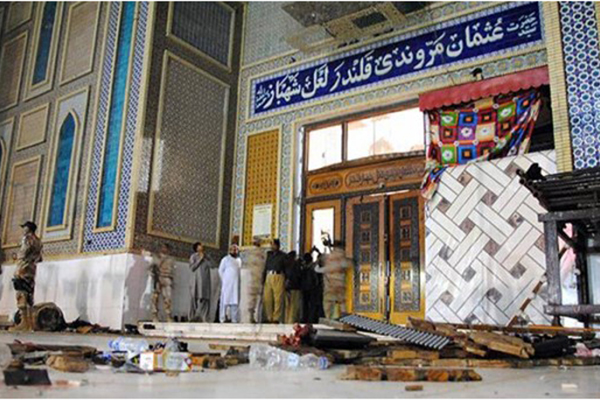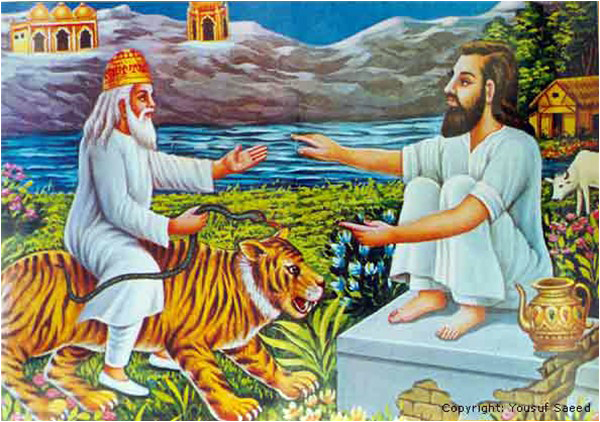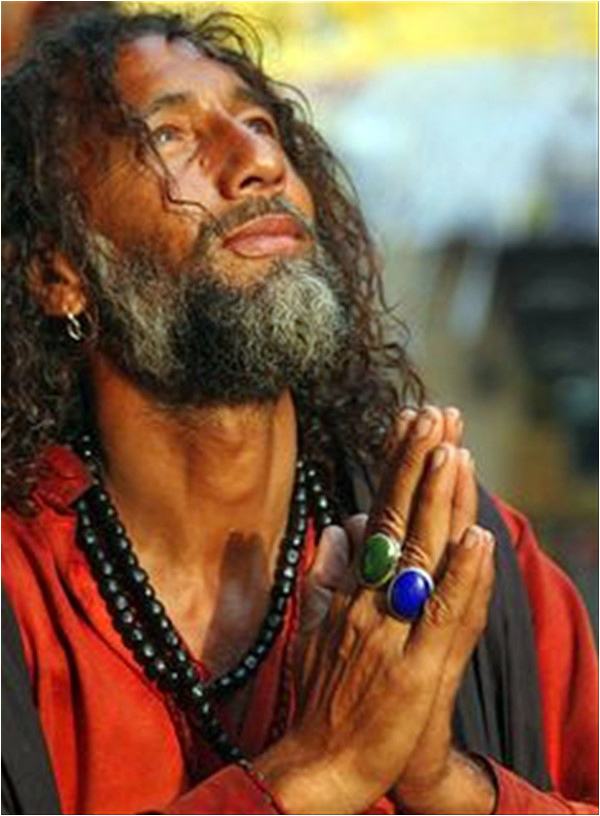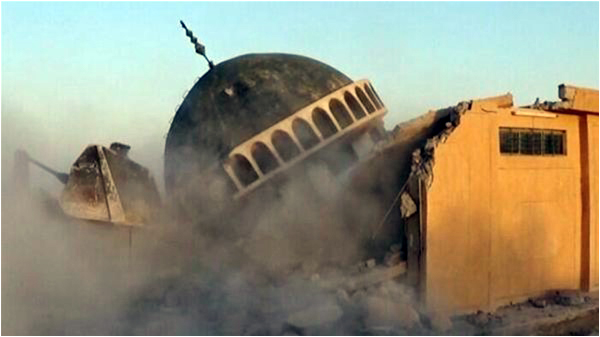The meaning of Sehwan
By Raza Rumi
Thefridaytimes : 10 Mar 2017
Why would contemporary terrorists mark it out for violence? Raza Rumi explains

Aftermath of the horrific attack at Sehwan
Sehwan, a dusty little town in Sindh, has been a source of inspiration and cultural dialogue for centuries. The shrine of Lal Shahbaz Qalandar (1178 – 1274 A.D.) is a reminder of many things – Pakistan’s pluralistic heritage, the lived faith for millions of its inhabitants and how fragile the constructed identity of the Islamic Republic is. This is why religious extremists on February 17 attacked this revered shrine, a home for the wretched of the earth. These militants did not come from the outside, but from within the folds of Pakistani society, that has been brutally splintered for the past seven decades.
The abode of a legendary mystic Lal Shahbaz continues to be a striking example of a polytheistic belief system and a vibrant space where the Muslim and non-Muslim find equal solace and engagement with the spiritual ecosystem. The annual urs of Lal Shahbaz is a moot for the Qalandars all over the country – and even outside – who congregate at the site to remember their master ascetic and his final union with the Creator.

Old man of the River Indus – folk and popular traditions about Jhule Lal, a water deity,
predate Islam in the Indus valley
The real name of Lal Shahbaz Qalandar was Sayyid Usman Shah Marwandi but he acquired the title Lal, red, due to his penchant for wearing red garments, and Shahbaz, falcon, for his elevated spirituality. Lal Shahbaz’s family drew their lineage from the House of Hazrat Ali (RA), Prophet Muhammad’s (pbuh) companion and son-in-law. The family migrated from Iraq and lived in Mashhad (in today’s Iran) before migrating to Marwand.
Lal Shahbaz was not the kind of ascetic to choose an imperial city such as Delhi or Lahore. He moved to Sehwan, Sindh in 1251 with a group of his disciples. He considered himself to be the spiritual disciple of Mansur Hallaj, the tenth-century martyred mystic poet of Baghdad. Hallaj had uttered the famous line ‘Ana’l-Haq’ (I am the Truth) and was persecuted by the clerics and the court leading to his death.

The teachings and imagery traditionally associated with Lal Shahbaz Qalandar are those of spirituality, uninhibited by narrow borders
Lal Shahbaz Qalandar is also referred to as Jhule Lal, one of the Hindu names for the god of water
Hallaj had also visited Sindh three hundred years before. Lal Shahbaz’s poetry was inspired by Hallaj’s view of mysticism where the beloved and the lover are not separate:
“I am burning with divine love every moment
Sometimes, I roll in the dust
And sometimes I dance on thorns
I have become notorious in your love
I beseech you to come to me!
I am not afraid of the disrepute,
To dance in every bazaar”
(translation found in ‘At the Shrine of the Red Sufi’ by Jurgen Wasim Frembgen)
The tradition holds that the Qalandar achieved union with God during a state of trance. This is why dancing at this shrine is central to the spiritual practice marking their gratitude. Dhamaal is an invocation, a kind of call to Lal Shahbaz.
I know nothing except love, intoxication and ecstasy. I am burning with the love of the Beloved. At one moment I am writing on the dust and in the other I am dancing on the thorns.

Religious pluralism in South Asia – depiction of a meeting between Muslim and Hindu sages – Photo Credits – Yousuf Saeed
Comments on my Facebook page suggested that the Sehwan attack was a much-needed occurrence and there was a need to bomb [and raze] all such shrines
Qalandar’s contemporaries were Chishti Sufi Baba Farid of Ajodhan, Shaykh Bahauddin Zakariya of Multan and Jalauddin Bukhari of Uch. In folklore they are referred to as ‘four great friends’. But Lal Shahbaz, unlike the others, was not the progenitor of a rigid, hierarchical Sufi order. The free-spirited nature of his life and spiritual pursuits make Sehwan even more of a complex arena than an orderly Sufi shrine. Its acceptance of all and sundry and its eclectic practices allowed for a huge impact on popular culture for centuries. But in terms of the multi-faith reverence, Sehwan follows the Sindhi spiritual-cultural traditions that cannot be separated from the mighty Indus River.
From the ancient Vedic times to stories told by Sufi saints, the Indus continues to play a central role in poetry, folklore and spiritual ethos. Until the 19th century, both Muslims and Hindus believed that the ebb and flow of the Indus depended on Lal Shahbaz Qalandar’s blessings. Lal Shahbaz Qalandar is also referred to as Jhule Lal, one of the Hindu names for the god of water. The Hindus referred him to as Raja Bharati.
Sehwan was also the location of a prominent Shiva centre. It is said that the name Sehwanistan has been derived from Sivistan, city of Shiva. Shiva is known in the Hindu mythology for his cosmic dance and stories related to him encapsulate sensual beauty. There is a striking similarity between the dressing of contemporary faqirs and Shivite yogis as both wear torn clothes with matted hair.

Sufi or Qalandari devotee from Punjab, Pakistan
All year round, thousands of people visit tombs as a way to show their respect and receive blessings. Just like Lal Shahbaz Qalandar, Khwaja Khizr is also referred to as Zindapir (Living Saint) and ‘pani ka badshah’ (Water King). The devotees still believe that he lives under the water and the river flows the way that he commands.
In Uderolal, the tomb of a saint referred to as Shaikh Tahir by the Muslims and by Jhulelal or Uderolal by the Hindus indicates similar intimacy. Both refer to him as the Zindapir. Udero Lal is also the saint of the water worshippers. Close to Sehwan, Laki Shah is a small place where visitors gather to purify their souls and bodies by bathing in the springs of Laki Shah. Similarly, in the localities of Mol Sharif, near Thano Bula Khan and Lahoot, water provides an arena for worship.
Shah Abdul Latif’s Risalo, a sacred Sindhi text, is also revered by both Hindus and Muslims. Risalo contains excerpts from the Quran, the traditions of the Prophet (pbuh), Persian mystical poetry and Sindhi folk references. It does not focus on any one form of religious authority and includes doctrines from various sects in Islam. At Latif’s shrine, the Quran and the Risalo were kept in a cradle, not too different from the treatment given to icons of baby Krishna.

Sheema Kermani’s defiant dhamaal soon after the terrorist attack on Sehwan attracted the ire of some fundamentalists and puritans
A sizeable number of the Hindus in Sindh consist of Nanakpathis, those who follow Guru Nanak (the founder of Sikhism). Historically, a clear-cut distinction between Sikhism and Hinduism has been absent in the region. Another instructive belief system recorded by late Samina Qureshi in her majestic book, Legends of the Indus was the idea of the Satpanthi community that Islam’s sacred figures were avatars of the Hindu god Vishnu.
Despite the creation of Pakistan, the syncretic culture in Sindh and Sehwan persisted, even under various phases of Pakistan’s gradual (and cynically political) Islamisation. The influence of Lal Shahbaz is immense in popular culture. The dhamaal and its numerous versions are found in Qawwali, film and pop music. In addition, Sehwan is the inspiration as well as the annual meeting point for thousands of enigmatic Qalandars – wandering ascetics. The identity of a Qalandar, Malang and Majzub, are overlapping and difficult to classify. Many are attached to Lal Shahbaz and the saint at Bari Imam near Islamabad.
Such was the deep bond of people with Sehwan that even the state refrained from imposing its one-dimensional view of culture here. I saw the shrine of Ali Hajvari aka Data Ganj Bakhsh or Data Saheb (also attacked by the Taliban in 2010) gradually change into a completely segregated space. Now women enter from a different gate and there is a strict separation of genders. A wall has been erected around the tomb to ensure that. Even in terms of the various material improvements, the shrine’s spatial character has changed overtime due to the excessive use of marble, chopping of almost every tree (vital to shrine compounds in South Asia) and neon lighting. The Punjab elites are wary of Data Saheb’s influence so the investments reflect their aesthetics as well as a desire to serve the needs of the visitors such as water, fans and heating in the winters. After the 2010 attack, Data Saheb is now a heavily guarded place with barricades, multiple checking points and security cameras. These measures are good in such times but one wonders how these centuries old-public spaces have been turned into security nightmares…
The shrine at Sehwan was largely oblivious to what was brewing outside its confines. Men, women and transgender persons participate in the dhamaal on Thursdays and other special occasions. Different faiths, sects and classes interact freely and there are lax rules on drugs and allegedly even sex trade in the town. This is why the puritans have been citing the existence of such vices as the cause for Sehwan carnage. That, alas, is a separate story.
The attack on Sehwan was not an attack on a highway, nor an attempt to sabotage cricket matches
Since 2006, dozens of Sufi shrines have been attacked in Pakistan. The Sehwan carnage was disturbing but not unexpected. Lahore’s Data Darbar, Sakhi Sarwar in D.G. Khan, Baba Farid in Pakpattan, Rehman Baba in Khyber-Pakhtunkhwa and Shah Noorani in Balochistan are some of the hugely popular tombs that have been bombed, mostly with the help of suicide bombers trained in madrassas and indoctrinated by the Wahabi-Salafi (and its South Asian cousin Deobandi) thought that shrine-worship is shirk (polytheism) punishable by death in Wahabi doctrine. In that worldview, such attacks are in line with the tenets of faith. We know this is a narrow, skewed understanding of the theological discourse but such ideas have been thriving in Pakistan.
A suicide bomber who failed to detonate himself at Sakhi Sarwar shrine in 2011, in an interview, said that he had been originally recruited for jihad in Afghanistan but diverted to South Punjab due to the shirk and murda parasti (worshipping the dead) prevalent at the shrines. Intriguingly, he said that the reason for this mission was the large number of kafirs (infidels) that had to be tackled. Such Pakistani kafirs, he was told, were greater in number – even more than America.
But not all shrine haters are madrassa graduates. Since 1970s, the Middle East has provided hundreds of thousands jobs to Pakistanis; and they return with cultural and religious ideas closer to the Wahabi reading of Islam. Saudi Arabia has funded numerous seminaries and many madrassas (and in some cases higher education) instructors are graduates from Saudi universities and institutes. But this is just a little segment of the larger story.
Since the 1980s, we have actively supported the creation of madrassas for the Afghan jihad and later for jihad in Kashmir. Suicide bombing and the infidel-killing are somewhat valid in only a few schools of thought amongst Muslims. To support this jihad culture, we changed our textbooks in the 1980s with express directions to inculcate the values of jihad and the state enabled media persons to propagate the values of religious warfare. Stories of defeating the Soviet Union via jihad are popular lore in contemporary Pakistan. In the past three decades, the jihadist ideology has found some measure of public support and allied mosque-madrassa networks have grown exponentially everywhere, including Sindh.

The Islamic State group, in pursuit of puritanical beliefs associated with Saudi Arabia, has regularly attacked shrines and other markers of pluralistic Islam
The ideology that considers killing civilians as justified views the Sufi practices as un-Islamic. This mindset considers Shias, Ismailis, Sufis and others as a threat to the pure version of Islam that militant groups are trying to establish across the Muslim world. Shrines have been razed in Mali, Iraq, Syria and many other countries as well. Pakistan hosted proponents of such transnational ideologies for years – and later found them as useful levers to bargain for power with the West. Elites have their twisted reasons for such complicity but it is the people who have suffered due to insecurity. In the process, the plural culture we once had has been severely dented. Shrine attacks are one such manifestation of this phenomenon.
South Asian Islam that evolved with the mingling of folk and pre-Islamic spiritual practices finds a rich expression through the shrine culture – the rituals, engagement and in some cases music and dancing. One cannot overlook the tragic reality that Sufi shrines have turned into nefarious extortionist enterprises and the descendants of many a saint exploit their position for economic and political power. Yet, they remain vibrant public spaces of spirituality, celebration and inclusion. By killing devotees and spreading terror, the imposition of a reductionist view of faith has been the leading motive of militants.
In 2015 and 2016, there was a relative decline in terror attacks due to a military operation against selected militias. Little attention was paid to madrassa reform. As many feared but were unable to express due to stifling of media debates, military action was not the solution to the complex issue of extremism. Now factions of Pakistani Taliban seem to have regrouped, and are turning into franchises of Da’esh (the Islamic State group) that has found some bases in Afghanistan.
Pakistan experienced at least nine attacks during the week when Sehwan was attacked. This surge was all too familiar. The last decade has seen a recurring pattern: targeting of state officials, civilians, crowded places and shrines. The state response is even more familiar. The civilian government and security establishment, for their own reasons, misinform the public that terrorism is a foreign attempt to destabilise Pakistan.
The latest target of destabilisation by ‘hostile’ countries is the $50 billion China Pakistan Economic Corridor. The ultimate dehumanisation takes place when in the public narrative: a highway takes precedence over the lives of ordinary Pakistanis who lack security and are ruled by elites that are not too concerned with the collateral damage of keeping militant infrastructure intact.
After the Sehwan attacks, the civil society groups in a show of defiance visited Qalandar’s shrine and performed dhamaal. Images of Sheema Kermani, a celebrated classical dancer and a fiery activist, dancing at the shrine, were heartwarming but also a bit gloomy. It was a picture that is now becoming all too familiar: the heroic efforts of few, unarmed secularists fighting the tide of bigotry aided by state and its favourite militias.
Immediately thereafter, social media commentaries concluded that Sheema had committed shirk and soon the debate degenerated into the favourite hobby horse of the right wing: that dancing and music were forbidden in Islam. There were muted references to the courage shown by civil society on the electronic media but new media, as a space for urban youth, exhibited a disturbing trend. An incredibly large number of responses, especially by young Pakistanis on Facebook and Twitter, were negative.
The post-Zia-ul-Haq generations have no immediate reference for the dhamaal. Until the late 1970s, Pakistani cinema had recurring references to dhamaal. Madam Nur Jehan sang some of the best numbers in such a context. Other singers such as Runa Laila and Naseem Begum also sang for the films invoking the blessings of Lal Shahbaz Qalandar. Today we live in the age of pop singers turned preachers and of Maulana Tariq Jamil’s lectures (hugely popular on Facebook) that deride heretic practices and refuse to condemn those who kill civilians.
The militant networks can be easily decimated by the military but the supportive ideology has more traction amongst otherwise ‘non-violent’ citizens. A few comments on my Facebook page suggested that the Sehwan attack was a much-needed occurrence and there was a need to bomb [and raze] all such shrines.
Aside from these problematic attitudes, the ‘resilience’ mantra (already beaten to death) re-emerged. People did not stop dancing at Sehwan, so we had solved the extremist problem. Every time an act of terror kills civilian or a natural disaster hits the poor and the state’s role is abysmally irresponsible and unaccountable, public debate is diverted towards the story of ‘resilience’. What choice do citizens have? What choice do the devotees of saints and tombs have? We don’t have counseling services available for even the affluent in the cities. Where are these people going to go? Even worse, the label of ‘martyr’ to a victim of plain terror is another deflection from holding the state responsible for its abject failure to provide security. Let us remember that security is a basic guarantee in the Constitution, central to even the most basic of citizen-state relationships.
This conflation of Pakistan’s jihadism since 1980s and the transnational Islamism manifested by Da’esh and Al-Qaeda is now yielding its toxic fruit. It does not help us if we continue to belabour the role of the West and the United States in supporting the mujahideen (which of course they did, and further messed it up through horrific wars in the Middle East). It is about us. In a multi-ethnic, religiously diverse society, can we afford to nurture sectarian hatreds and violent ideas?
The attack on Sehwan was not an attack on a highway, nor an attempt to sabotage cricket matches. It was a reminder that we have allowed perverse ideologies to take root in the country for short-term strategic objectives, the efficacy of which is neither debated in the parliament nor the media.
Sehwan as an expression of counterculture, of allowing human bodies to find expression in a sacred realm, of providing voice to the voiceless, needs to be treasured. Adding security cameras and more policemen will not help unless the numerous madrassas that have sprung up in Sindh are regulated and converted into standardised schools that don’t glorify suicide bombers. This is beyond the mandate of provincial police. It is linked to national security and we all know who looks after that.
Whilst this may take time, we shall continue to chant Dam a Dam Mast Qalandar…
Raza Rumi is a scholar in residence at Ithaca College and Visiting Faculty at Cornell University